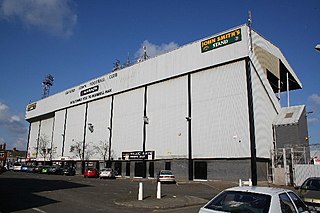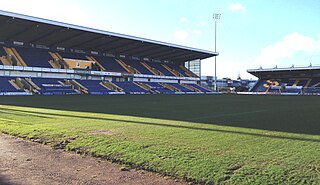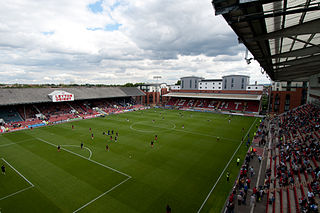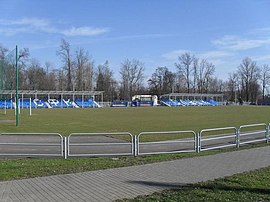
Kirklees Stadium, currently known as the John Smith's Stadium for sponsorship reasons, is a multi-purpose stadium in Huddersfield, West Yorkshire, England. Since 1994, it has been the home ground of Huddersfield Town Association Football Club and Huddersfield Giants Rugby League Football Club, both of whom moved from Leeds Road.

Sincil Bank Stadium, known for sponsorship reasons as LNER Stadium, is a football stadium in Lincoln, England, which has been the home of Lincoln City since 1895. Previously, Lincoln City had played at the nearby John O'Gaunts ground since the club's inception in 1884. The stadium has an overall capacity of 10,669. It is overlooked by Lincoln Cathedral. Former Lincoln City chairman John Reames re-purchased the ground from the local council in 2000 at a cost of £175,000. The club had sold it in 1982 for £225,000 in order to fend off the threat of eviction, arranging a 125-year lease.

Blundell Park is a football ground in Cleethorpes, North East Lincolnshire, England and home to Grimsby Town Football Club. The stadium was built in 1899, but only one of the original stands remains. The current capacity of the ground is 9,052, after being made all-seater in summer 1995, reducing the number from around 27,000. Several relegations in previous years meant the expansion seating was also taken away; that reduced the capacity further from around 12,000 to what it is now.

Dinamo National Olympic Stadium is a multi-purpose stadium in Minsk, Belarus. It first opened in 1934 and has had several renovations over the years, reopening after the latest one in 2017. Earlier it was used mostly for football matches and was the home ground of Dinamo Minsk, FC Minsk and the Belarus national football team. Previously the stadium officially held 41,040, but because part of the upper stand had been abandoned in the mid-1990s for safety reasons, the actual capacity before renovations was 33,942. After renovation the capacity is only 22,246.

Gresty Road or the Alexandra Stadium, currently known as the Mornflake Stadium for sponsorship reasons, is a football stadium in Crewe, Cheshire, England. The home ground of Crewe Alexandra, it has an all-seated capacity of 10,153.

Field Mill, currently known as One Call Stadium for sponsorship reasons, is a football ground in Mansfield, Nottinghamshire, England, and the home of Mansfield Town Football Club.

Brisbane Road, currently known as the Gaughan Group Stadium for sponsorship reasons and originally known as Osborne Road, is a football stadium in Leyton, East London, England. It has been the home ground of Leyton Orient since 1937, before which it was the home of amateur football team Leyton, who moved to the Hare and Hounds ground. Since 2022 it has also been home to Tottenham Hotspur Women.

The Millmoor Ground, commonly known as Millmoor, is a football stadium in Rotherham, South Yorkshire, England. It was the home ground of Rotherham County between 1907 and 1925, and then its successor Rotherham United until 2008. The stadium has had no professional tenant since, but has been in use again for local youth football since 2016. It has been described as "the spiritual home" of Rotherham United.

Ostfriesland-Stadion is a multi-use stadium in Emden, Germany. It is used exclusively for football matches and has been the home stadium of Kickers Emden since 1950.

De Vliert is a multi-use stadium in 's-Hertogenbosch, Netherlands. It is currently used mostly for football matches and is the home stadium of FC Den Bosch. The original stadium was built in 1951, included an athletics track and had at its heyday a capacity of 30,000, making it one of the largest stadiums in the Netherlands. The old stadium was replaced previously in 1997 by the new stadium, which saw the field rotated 90° and is currently able to hold 8,500 people. The grandstands are partially heated by infrared heaters to provide comfort to spectators.

Stadion an der Bremer Brücke or Bremer Brücke is a football stadium in the Schinkel district of Osnabrück, Germany. It is used mostly for football matches and is the home stadium of VfL Osnabrück. The stadium currently holds 16,100 people and was opened in 1933.

Kostanay Central Stadium is a multi-purpose stadium in Kostanay, Kazakhstan. It is currently used mostly for football matches and is the home stadium of FC Tobol.
The Seedhill Football Ground was a football stadium in Nelson, Lancashire. It was the home of various incarnations of current North West Counties League Division One side Nelson F.C. from 1889, when the Burnley Express reported an opening senior fixture played against Burnley on 16 March 1889, until 1971. During their tenure at Seedhill, Nelson were members of the English Football League between 1921 and 1931. Nelson's last game at Seedhill was a Lancashire Combination fixture on Sunday 28 March 1971 against local rivals, Clitheroe F.C. Local newspaper, the Nelson Leader, reported that a crowd of over a thousand gathered to see Clitheroe beaten by five goals to three in what was not only the last game but also the first Sunday game at the stadium. Nelson then moved to their current Victoria Park ground on Lomeshaye Holme for the start of the 1971–72 season. Seedhill football ground was demolished in the early 1980s to make way for the M65 motorway.

Stadion kraj Bistrice, also known as Gradski stadion Nikšić, is a multi-purpose stadium in Nikšić, Montenegro. It is currently used mostly for football matches and is the home ground of FK Sutjeska and a host of Montenegro national under-21 football team matches. The stadium had a total of 5,214 seats before the addition of a new west stand in 2020.

The Recreation Ground, currently known as The EBB Stadium at The Recreation Ground for sponsorship reasons and informally known as The Rec, is a football ground in Aldershot, Hampshire, England. Football matches have been played there since 1927 when Aldershot was founded. The ground hosted league football between 1932 and 1992 when Aldershot were members of the Football League. Its current tenants Aldershot Town have used the ground since forming in 1992 and the ground once again hosted league football between 2008 and 2013.

The Citadel, previously known as Throstle Nest, is a football ground situated in Farsley, in the Metropolitan District of the City of Leeds in England, and is the current home of Farsley Celtic. It has a capacity of 3,900, 400 of which are seated. For the 2007–08 season Farsley Celtic agreed to let Leeds Met Carnegie also play at the ground.

The New York Stadium, currently known as the AESSEAL New York Stadium for sponsorship reasons, is a football stadium in Rotherham, South Yorkshire, England. Opened in July 2012, it is the home ground of Rotherham United Football Club, with a capacity of 12,021.
Acadian Park, also known as Acadian Ballpark, is a baseball stadium located in New Iberia, Louisiana, United States. It served as the home ballpark for the New Iberia Rebels, New Iberia Pelicans, New Iberia Cardinals and New Iberia Indians, each of whom played in the Evangeline League.

SFC Slutsk is a Belarusian association football club based in Slutsk, Minsk Oblast.
Shakhtyor Stadium is a multi-purpose stadium in Soligorsk, Belarus. It is currently used mostly for football matches and is the home ground of Shakhtyor Soligorsk reserve team. The stadium original capacity was 5,000, until the new seats were installed which reduced the capacity to the current 2,000 people.


















